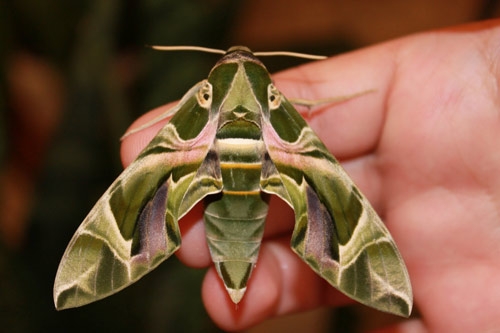Oleander Hawk-moth

It is a very hot summer. Scent of blooming oleanders is in the air. In the twilight of the coming night a flickering silhouette of a moth is appearing. This is the Oleander Hawk-moth or Army Green Moth (Daphnis nerii) (formerly Deilephila nerii). It inhabits areas with warm climates in Europe, Africa and Asia. Despite being one of the most common butterflies of the Sphingidae family, for Bulgaria it is a very rare species.
Perhaps the reason is in the fact that its caterpillars feed on oleander leaves, and in Bulgaria this plant is grown mostly artificial, in pots. On this way that butterfly caught in our museum. They brought us some pots with beautiful oleanders. About two weeks later, to our great surprise and delight, we found among the leaves, not 1 or 2, but 4 caterpillars. With a size of 8.5 cm, they are bright green with two characteristic blue spots resembling eyes and have bright yellow spike at the end of the body. Sideways they have a white stripe with scattered small white and blue spots. With a large appetite they “destroy” the oleander leaves and growing rapidly. The plant itself is poisonous and the caterpillars also accumulate toxins in their bodies. This is to protect them from predators. Prior to pupate, the caterpillars change their color to yellow-brown and hide among the fallen leaves into the roots of the plant. The Pupa is up to 7.5 cm, brown with black spots sideways.
Adult Oleander Hawk-moths fly from May to September, sometimes till October. Usually they spend the day hiding in the plants, where their colouration is helping them for this. Their wings are olive green above; the thorax is dark green and the abdomen – gray-green with bright patches. The wings have beautiful cross or longitudinal pink, purple or gray-white spots. Their size is up to 11.5 cm.
What happened to our caterpillars caught accidentally in the museum? Well, they pupate and after about two weeks of pupae hatched wonderful Oleander Hawk-moths who we released outdoors in wild nature.











